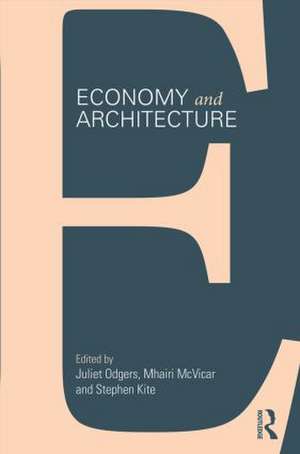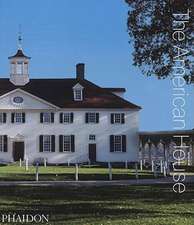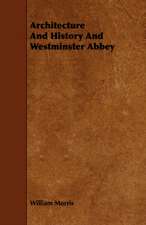Economy and Architecture
Editat de Juliet Odgers, Mhairi McVicar, Stephen Kiteen Limba Engleză Paperback – 22 iul 2015
The book addresses the challenges of practicing architecture within the strictures of contemporary economies, grounded on the fundamental definition of ‘economy’ as the well managed household – derived from the Greek oikonomia – oikos (house) and nemein (manage). The diverse enquiries of the study are structured around the following key questions:
- How do we define our economies?
- How are the values of architecture negotiated among the various actors involved?
- How do we manage the production of a good architecture within any particular system?
- How does political economy frame and influence architecture?
| Toate formatele și edițiile | Preț | Express |
|---|---|---|
| Paperback (1) | 450.40 lei 6-8 săpt. | |
| Taylor & Francis – 22 iul 2015 | 450.40 lei 6-8 săpt. | |
| Hardback (1) | 1278.08 lei 6-8 săpt. | |
| Taylor & Francis – 31 iul 2015 | 1278.08 lei 6-8 săpt. |
Preț: 450.40 lei
Nou
Puncte Express: 676
Preț estimativ în valută:
86.18€ • 90.22$ • 71.31£
86.18€ • 90.22$ • 71.31£
Carte tipărită la comandă
Livrare economică 05-19 aprilie
Preluare comenzi: 021 569.72.76
Specificații
ISBN-13: 9781138025486
ISBN-10: 1138025488
Pagini: 284
Ilustrații: 1 black & white tables, 40 black & white halftones, 8 black & white line drawings
Dimensiuni: 156 x 234 x 10 mm
Greutate: 0.48 kg
Ediția:1
Editura: Taylor & Francis
Colecția Routledge
Locul publicării:Oxford, United Kingdom
ISBN-10: 1138025488
Pagini: 284
Ilustrații: 1 black & white tables, 40 black & white halftones, 8 black & white line drawings
Dimensiuni: 156 x 234 x 10 mm
Greutate: 0.48 kg
Ediția:1
Editura: Taylor & Francis
Colecția Routledge
Locul publicării:Oxford, United Kingdom
Public țintă
Postgraduate, Professional, and UndergraduateCuprins
Illustration Credits Notes on Contributors Acknowledgements Foreword David Leatherbarrow Introduction Juliet Odgers, Mhairi McVicar, Stephen Kite Part 1: Defining Households 1. Equalitarianism Simon Sadler 2. The Earthly Paradise of Economie Sociale Diana Periton 3. Parker Morris and the Economies of the Fordist House Gary Boyd 4. Care of Commons: Exploring Questions of Care, Gifts and Reciprocity in Making New Commons Kim Trogal 5. John Evelyn’s Villa at Sayes Court: A Microcosm of Labour and Love Juliet Odgers Part 2: Negotiating Values 6. Architectural Husbandry Christine Stevenson 7. Home Economics Flora Samuel 8. Four Economies of Architecture Adam Sharr 9. The Libidinal Economy of Architecture: Skin, Membranes and Other Surfaces of Desire Chris Smith 10. Architectural Renewal and Poetic Persistence: Investing in an Economy of Stories Lisa Landrum Part 3: Managing Production 11. Scarcity Constructs Jeremy Till 12. Economy of Means Jonathan Sergison 13. An Optional Extra: Valuing Architecture at the Brompton Boilers Mhairi McVicar 14. The Architect: A Disappearing Species in a Financialized Space? Silke Ötsch 15. The Pan-American Highway: Informal Urbanism in Latin-American Border Cities Cristian Suau Part 4: Politics and Economy 16. The Death and Life of PFI Urbanism Owen Hatherley 17. A Stimulus for Education: Global Economic Events and the Design of Australian Schools Hannah Lewi and Cameron Logan 18. Restricted by Scarcity, Striving for Greater Bounty: The Role of Architecture in Making Dubai Kevin Mitchell 19. Designing Public Space in Austerity Britain Suzanne Hall 20. The Bricks of Venice: Material and Craft in John Ruskin’s Political Economy Stephen Kite Select Bibliography Index
Notă biografică
Juliet Odgers is Lecturer in Architecture at the Welsh School of Architecture, Cardiff University. This is the third in a series of edited books by Routledge to which she has contributed as editor, the others are Primitive: Original Matters in Architecture (2008), and Quality out of Control: Standards for measuring Architecture, (2010). Her primary research field is in early modern garden design and visions of nature, on which see, ‘Gaffarel’s Influence on John Evelyn’, in Jacques Gaffarel : between Magic and Science, (Rome: Serra, 2014). She is an editor of Architectural Research Quarterly, (CUP).
Mhairi McVicar is Senior Lecturer at the Welsh School of Architecture. Her research investigates the pursuit of precision and its consequences in architectural practice. Recent publications include ‘Specifying intent at the Museum of Childhood’ in Architectural Research Quarterly (2012), 'God is in the details/The detail is moot: A meeting between Koolhaas and Mies’ in Reading Architecture and Culture: Researching Buildings, Spaces and Documents (Routledge, 2012) and ‘Passion and Control: Lewerentz and a mortar joint’ in Quality Out of Control (Routledge, 2010).
Stephen Kite is a Professor at the Welsh School of Architecture, Cardiff University, Wales, UK. His research explores the history and theory of architecture and its wider connections to visual culture. His recent books are a study of the critical writings on architecture and art of Adrian Stokes: Adrian Stokes: An Architectonic Eye (MHRA, Legenda, 2009), and an examination of the evolution of Ruskin’s observation of architecture: Building Ruskin’s Italy: Watching Architecture (Farnham: Ashgate, 2012). His current book project is Shadow Makers: a Cultural History of Shadows in Architecture (London: Bloomsbury, forthcoming). He is an editor of Architectural Research Quarterly, (CUP).
Mhairi McVicar is Senior Lecturer at the Welsh School of Architecture. Her research investigates the pursuit of precision and its consequences in architectural practice. Recent publications include ‘Specifying intent at the Museum of Childhood’ in Architectural Research Quarterly (2012), 'God is in the details/The detail is moot: A meeting between Koolhaas and Mies’ in Reading Architecture and Culture: Researching Buildings, Spaces and Documents (Routledge, 2012) and ‘Passion and Control: Lewerentz and a mortar joint’ in Quality Out of Control (Routledge, 2010).
Stephen Kite is a Professor at the Welsh School of Architecture, Cardiff University, Wales, UK. His research explores the history and theory of architecture and its wider connections to visual culture. His recent books are a study of the critical writings on architecture and art of Adrian Stokes: Adrian Stokes: An Architectonic Eye (MHRA, Legenda, 2009), and an examination of the evolution of Ruskin’s observation of architecture: Building Ruskin’s Italy: Watching Architecture (Farnham: Ashgate, 2012). His current book project is Shadow Makers: a Cultural History of Shadows in Architecture (London: Bloomsbury, forthcoming). He is an editor of Architectural Research Quarterly, (CUP).
Descriere
This book takes a critical look at contemporary architecture from across the globe, whilst extending its range back in history as far as the Homeric epics of ancient Greece.







